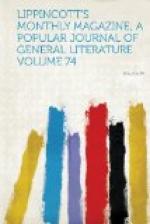Few religious revolutions have involved results so, complex as the Raskol, yet few have been simpler in their inception. The countless sects which for two centuries have had their being among the Russian people took their rise, in general, from the revision of the liturgy. One stock produced them nearly all: only a few sects (though these, by the way, are by no means the least curious) date from an earlier time or have another origin than this liturgic reform. The Middle Ages in Russia, as elsewhere, were marked by the rise of heresies. Of these the oldest may have arisen before the Mongol conquest, from contact with Greeks or Slaves, particularly with the Bulgarian Bogomiles, the ancestors or Oriental brethren of the Albigenses. Other heresies sprang up later in the North, in the Novgorod region, from intercourse with Jewish or other Western traders. Of most of these the name alone remains: such are the Martinovtsy, the Strigolniki, the Judaizers, and so on. All these sects were dying away when the Raskol broke out; and it absorbed all the vague, embryonic beliefs floating in the popular mind. Some of these antique heresies—the Strigolniki, for instance—after having disappeared from history, seem to have come to light again in the shape of certain sects of our own days; and one might fancy that they had been for centuries running on in an underground channel.
In the dim disputes of mediaeval times, however, one may make out with some clearness the fundamental principle of the Raskol: it is a scrupulous veneration for the letter—formalism, in a word. “In such a year,” says a Novgorod chronicler of the fifteenth century, “certain philosophers began to chant, ‘O Lord, have mercy upon us!’ while others said, ‘Lord, have mercy upon us!’"[004] In this remark the whole Raskol stands revealed. Controversies like these begat the schism which has rent the Russian Church asunder. Religious invocations have for this people the nature of magical formulae, the slightest change in which destroys their efficacy. The Russian clings to the heathen feeling, though he hides it under a Christian veil. He believes in the power of particular words and gestures. He still seems to regard his priest as a kind of chaman, religious ceremonies as enchantments, and religion in general as witchcraft. A fondness for rites (obriad) is indeed one of the characteristics of the inhabitant of Greater Russia. The way in which Russia was converted to Christianity has




